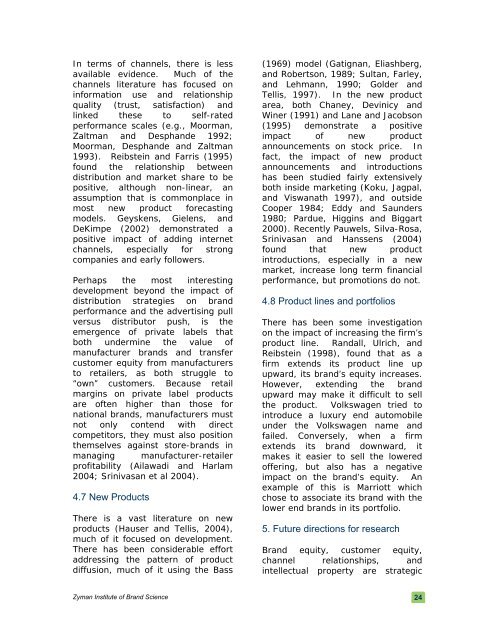Linking Marketing Metrics to Financial Performance - Emory ...
Linking Marketing Metrics to Financial Performance - Emory ...
Linking Marketing Metrics to Financial Performance - Emory ...
Create successful ePaper yourself
Turn your PDF publications into a flip-book with our unique Google optimized e-Paper software.
In terms of channels, there is lessavailable evidence. Much of thechannels literature has focused oninformation use and relationshipquality (trust, satisfaction) andlinked these <strong>to</strong> self-ratedperformance scales (e.g., Moorman,Zaltman and Desphande 1992;Moorman, Desphande and Zaltman1993). Reibstein and Farris (1995)found the relationship betweendistribution and market share <strong>to</strong> bepositive, although non-linear, anassumption that is commonplace inmost new product forecastingmodels. Geyskens, Gielens, andDeKimpe (2002) demonstrated apositive impact of adding internetchannels, especially for strongcompanies and early followers.Perhaps the most interestingdevelopment beyond the impact ofdistribution strategies on brandperformance and the advertising pullversus distribu<strong>to</strong>r push, is theemergence of private labels thatboth undermine the value ofmanufacturer brands and transfercus<strong>to</strong>mer equity from manufacturers<strong>to</strong> retailers, as both struggle <strong>to</strong>“own” cus<strong>to</strong>mers. Because retailmargins on private label productsare often higher than those fornational brands, manufacturers mustnot only contend with directcompeti<strong>to</strong>rs, they must also positionthemselves against s<strong>to</strong>re-brands inmanaging manufacturer-retailerprofitability (Ailawadi and Harlam2004; Srinivasan et al 2004).4.7 New ProductsThere is a vast literature on newproducts (Hauser and Tellis, 2004),much of it focused on development.There has been considerable effortaddressing the pattern of productdiffusion, much of it using the Bass(1969) model (Gatignan, Eliashberg,and Robertson, 1989; Sultan, Farley,and Lehmann, 1990; Golder andTellis, 1997). In the new productarea, both Chaney, Devinicy andWiner (1991) and Lane and Jacobson(1995) demonstrate a positiveimpact of new productannouncements on s<strong>to</strong>ck price. Infact, the impact of new productannouncements and introductionshas been studied fairly extensivelyboth inside marketing (Koku, Jagpal,and Viswanath 1997), and outsideCooper 1984; Eddy and Saunders1980; Pardue, Higgins and Biggart2000). Recently Pauwels, Silva-Rosa,Srinivasan and Hanssens (2004)found that new productintroductions, especially in a newmarket, increase long term financialperformance, but promotions do not.4.8 Product lines and portfoliosThere has been some investigationon the impact of increasing the firm’sproduct line. Randall, Ulrich, andReibstein (1998), found that as afirm extends its product line upupward, its brand’s equity increases.However, extending the brandupward may make it difficult <strong>to</strong> sellthe product. Volkswagen tried <strong>to</strong>introduce a luxury end au<strong>to</strong>mobileunder the Volkswagen name andfailed. Conversely, when a firmextends its brand downward, itmakes it easier <strong>to</strong> sell the loweredoffering, but also has a negativeimpact on the brand’s equity. Anexample of this is Marriott whichchose <strong>to</strong> associate its brand with thelower end brands in its portfolio.5. Future directions for researchBrand equity, cus<strong>to</strong>mer equity,channel relationships, andintellectual property are strategicZyman Institute of Brand Science 24





